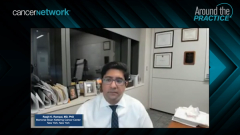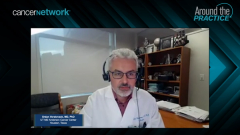
Stem Cell Transplants in Myelofibrosis
Best practices in determining eligibility and preparing patients with myelofibrosis for allogeneic stem cell transplantation.
Episodes in this series

John Mascarenhas, MD: Aaron, I’ll ask you this question. When do you prefer to introduce your MF [myelofibrosis] patient to a transplanter? Is it upon first meet and greet, or as they’re progressing, or once they’re high risk? Is there an optimal time to? Because as you know, and we’ve talked about before, that’s a complicated discussion and understanding the benefits and risks of transplants. So when do you initiate that?
Aaron T. Gerds, MD: Yes, that’s certainly a very nuanced conversation for sure. I think one of the challenges is overcoming the misconception that if you send your car to Tuffy, you’re going to get your oil changed. If you send a patient to a transplanter, it doesn’t necessarily mean the transplanter is going to transplant the patient. It’s not a bad idea, especially for patients with a couple of high-risk factors. At least getting them in touch with a transplanter, getting the HLA [human leukocyte antigen] typing done, having those conversations about what transplant may look like, identifying a caregiver, coming up with some plans in case you need them in the future. I think that is, at any point in time, for a patient that may need a transplant in the foreseeable future—within the next 5, 10 years even, makes a lot of sense. That way that information is out there and they’ve established those relationships. I think there’s really no wrong time to send someone to a transplanter. I just think you have to explain that “Hey, we may not be transplanting right now, but we just want to get this information. We want to get some groundwork laid for that if we ever need to use it in the future.” That is, of course, an ongoing discussion. Sometimes patients will say, “Well, what’s going to happen to me over the next several years?” We would then pull out the MYSEC-PM [Myelofibrosis Secondary to PV and ET Prognostic Model], or pull out DIPSS [Dynamic International Prognostic Scoring System], or MIPSS [Mutation-Enhanced International Prognostic Scoring System], or whatever IPSS [International Prognostic Scoring System] there is, but I’ll say a lot of times what predicts the future is the past. You can get a kinetic for an individual’s disease. Building that relationship, as Srdan said, is so important over time because you get a clinical feel for what may happen. If you have a transplanter already kind of ready to go, when you get a sense that the disease is changing, you can really start to make that transition more quickly.
John Mascarenhas, MD: Excellent. I totally agree with you. For me, the best time to introduce a patient to transplant is the present time. I think it’s such an ongoing discussion. If the patient is even a transplant-eligible patient at any point in the course, it’s probably a good idea to have them meet them earlier on because I think it’s much harder to have that discussion when a patient is getting sicker and other things can get in the way. And, of course, it takes time to mobilize a transplant too.
Transcript edited for clarity.
Newsletter
Stay up to date on recent advances in the multidisciplinary approach to cancer.


















































































